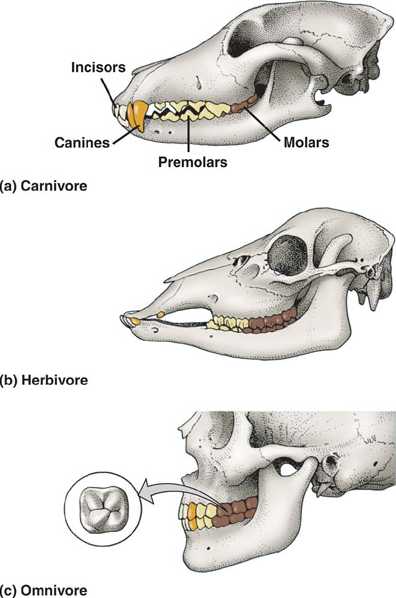
Incisors - used for cutting/snipping
Canines - used for slicing (usually meat)
Premolars - shape varies a bit depending on diet. Meat eater's premolars look more like canines and herbivores look more like molars.
Molars - Used for grinding food.
The types of teeth and the proportion of them in the skull are a good indicator of diet.

In the case of the carnivore here, the incisors are used to grip and pull meat of the carcass, the canines and premolars slice the food up.
In the case of the herbivore, the incisors are used to crop the vegetation and then the molars grind it up into a very fine paste. How much surface area is here and why?
In the case of omnivores, there are a bit of everything in the jaw so that all food types can be dealt with.
Herbivores have particular challenges with their food. It is rich in cellulose and has little else. Cellulose cannot be digested by animals and so herbivores enlist the help of microorganisms to digest it for them. In return they get a safe environment and a constant supply of food. Because the bulk of plant material is cellulose, herbivores need to eat often to ensure they get adequate proteins and other nutrients from their food.

To ensure that the food is sufficiently broken down (a process known as chemical digestion), herbivores have adopted 2 different strategies, fermentation taking place in a rumen or multi-chambered stomach (foregut fermentors) or in a chamber where small and large intestines meet called a caecum (hindgut fermentors). When the microorganisms have gone to work on the food in these chambers, nutrients are released and then can be absorbed into the bloodstream.
In the case of nectar eating animals and carnivores, the digestive tract is much more straightforward. You will need to figure out why yourself as part of your research.
Chemical digestion is very important in animals. Most of the food types we eat are not soluble in water. Because of this they need to be treated so that they are rendered soluble in order to enter the blood stream. The most typical types of chemical breakdown that you may recognise are the breakdown of protein (as found in meats) into amino acids, or starches (as found in bread for example), into sugars.
No comments:
Post a Comment